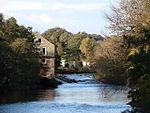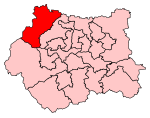Swastika Stone

The Swastika Stone is a stone adorned with a design that resembles a swastika, located on the Woodhouse Crag on the northern edge of Ilkley Moor in West Yorkshire, England. The design has a double outline with four curved arms and an attached S-shape, each enclosing a so-called 'cup' mark, the like of which can be found on other stones nearby. The stone is not verifiably dated, however the academic consensus suggests it to have been carved sometime around the Neolithic or early Bronze Age.Alternative views have claimed the design is rare in the British Isles, so its close similarity to Camunian rose designs in Italy have led some to theorise that the two are connected. In fact, the troops stationed in Ilkley during Roman occupation were recruited from the Celtic Lingones. This tribe was native to Gaul, but in around 400 BC, some migrated across the Alps to the Adriatic coast. Some believe the Ilkley Lingones were recruited from here rather than from Gaul. It is possible that the Italian Lingones passed through the Valcamonica region at some point, took on the swastika designs they found as part of their tribal symbolism, and carved it on the nearby moor when stationed in Ilkley.
Excerpt from the Wikipedia article Swastika Stone (License: CC BY-SA 3.0, Authors, Images).Swastika Stone
Moorside Lane, Bradford
Geographical coordinates (GPS) Address Nearby Places Show on map
Geographical coordinates (GPS)
| Latitude | Longitude |
|---|---|
| N 53.918888888889 ° | E -1.8619444444444 ° |
Address
High Cote
Moorside Lane
LS29 9JY Bradford
England, United Kingdom
Open on Google Maps








